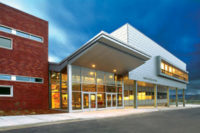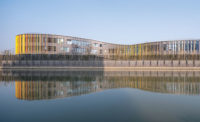Pasadena, California
On a sunny afternoon in Pasadena, California, an energetic sixth grader runs between the ginkgo trees in the large circular courtyard of Blair International Baccalaureate Middle School. Asked what he likes best about it, he stops, stretches, and replies, 'The shape. It's fun.'
At first glance, the new building by GKKWorks seems to be thoroughly modern, with lots of curves and openness, transparency modulated by fritted glass, and a taut and colorful skin of concrete rainscreen panels over a steel moment frame. It has earned LEED Silver certification. But a closer look reveals that those seemingly organic curves'or fun shapes'originate in a rigorously symmetrical axial plan.
According to design principal Edmund Einy, 'The geometry of the plan stems from the idea of a protected open space.' It also comes from, and helps to resolve, the irregular site. Flanking the large courtyard are rectilinear bars of classrooms. These are splayed symmetrically about a central axis, which links the large courtyard to a smaller one, also circular, and to a park and views of the San Gabriel Mountains. The classrooms are orthogonal, but the spaces between them derive their forms from the radial geometry of the courtyards. This elegant strategy recalls classical precedents, such as French h'tels particuliers, which created geometrically regular spaces on irregular urban sites. It also recalls a baseball diamond.
The 34,930-square-foot school accommodates 650 students, grades six to eight. It includes 26 classrooms, food service, and administrative offices'all organized around the large courtyard. Part of a broader campus, the new middle school shares gymnasium and support services with Blair High School and will eventually sit within the adjacent park, as the city plans to close the street between them in 2014.
Einy and senior project designer Devan Mitchell collaborated with the Pasadena Unified School District (PUSD) to challenge conventional assumptions about school design and to establish how this school could advance the district's educational goals. Foremost among these was to improve student performance by creating an atmosphere that enhances alertness and attentiveness. To that end, the architects utilized two primary program elements: the universal-classroom model, which emphasizes flexibility, and plenty of multipurpose outdoor space.
Classrooms, typically 30 by 32 feet with 10-foot ceilings, maximize both daylight and interaction among teachers and students. The daylight comes from generous glazing on two parallel walls. On the courtyard side, the glass is fritted with a bright-red dot screen to obscure views, thereby minimizing distractions. Doors connecting adjacent rooms encourage casual contact between teachers. Student tables and chairs can be grouped in small or large pods or in traditional rows. Three of four walls are equipped with whiteboards, tackable panels, and projection screens, so teachers are free to move around. According to Einy, 'The more teachers move and change the environment in the classroom, the more students are encouraged out of their comfort zone, to participate and become empowered in the learning process.'
Multipurpose outdoor spaces, well suited to the mild climate, encourage teaching, learning, and socializing in the open air. The large circular courtyard, planted with ginkgos to evoke a forest, is designed to foster social learning. It accommodates graduations, assemblies, exhibits, and performances, as well as daily lessons for which students simply bring their chairs outside. Between classes, kinetic crowds of students animate the grounds with activity. Other outdoor spaces include a semi-enclosed lunch shelter, as well as the smaller courtyard'with a mature maple at its center and benches at its perimeter'doing double duty as main entry and reading room. On the second floor, open spaces between classrooms frame mountain views.
Because of the central courtyard, there are no double-loaded corridors and no separation of programs. Students and teachers enter and exit classes here and enjoy the abundance of light, air, and room-to-move it provides. This open space also frees the school of hierarchy. With all program elements weighted equally around it, everyone is visible, and the school functions as a cohesive social unit. Students can interact among grade levels.
The two-story building defers to its low-rise residential setting with a one-story base of warm gray ceramic tiles surrounded by a ground plane planted with grasses, shrubs, and cypress trees. In contrast to this neutral backdrop, concrete panels wrap much of the remaining structure in sea-foam green (a variation on the school color), with a terra-cotta hue in the courtyard. Some street-facing panels are permanently pivoted open to reveal large windows, providing focused views and light, along with protection from the sun. A rounded corner, behind which sits the smaller courtyard, marks the main entry. Here the panels are interrupted by large openings in which a galvanized-steel grid maintains both the elevation's panel module and the plan's radial shape. This rhythm of voids and solids allows the building to strike a delicate balance between enclosure for students and teachers and accessibility to the neighborhood.
Teachers give the school high marks. 'I appreciate the light and openness and the geometry of the design,' says an art teacher. 'The kids like it too. To them it's playful, like a toy.' According to a history teacher, 'The quality of the building signals a quality education. The environment makes students feel valuable. The kids are proud to be here.' That's what happens when you combine the modernist virtues of space, light, and air with the classical virtues of firmness, commodity, and delight.
James Gauer is an architect based in Victoria, B.C., and the author of The New American Dream: Living Well in Small Homes.
Completion Date: September 2011
Gross square footage: 34,930 square feet
Total construction cost: $13 million
People
Owner:
Architect:
Personnel in architect's firm who should receive special credit:
Interior designer:
Engineers
Mechanical Engineer:
Landscape Architect:
General contractor:
Photographer(s):
Kevin Tittle Photography
CAD system, project management, or other software used: |
Products
Structural system
Exterior cladding:
Roofing:
Windows:
Skylights:
Glazing:
Doors:
Entrances:
Wood doors:
Locksets:
Closers:
Exit devices:
Pulls:
Interior finishes
Kitchen:
Paints and stains:
Wall coverings:
Window Coverings:
Paneling:
Plastic laminate:
Solid surfacing:
Floor and wall tile (cite where used):
Carpet:
Lighting
Downlights:
Exterior lighting:
Dimming System or other lighting controls:
Conveyance
Plumbing
Water fountains: |











Post a comment to this article
Report Abusive Comment